Our guest blogger is Alexus Eudell, a graduate student in Library and Information Science (LIS) at the Catholic University of America, who completed her LIS practicum at the Rare Books in the Summer of 2023.
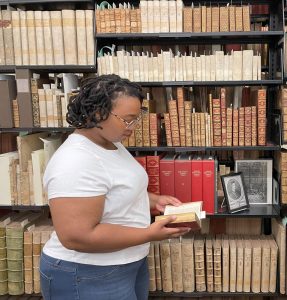
I began my internship with the Rare Books department with Alex Audziayuk, the Rare Books Librarian, on June 7, 2023. My last day was August 9, 2023. I completed 120 hours during my time there. In the Rare Books department, my main project was the Clementine Library. The Clementine Library is a collection named for Pope Clement XI, one of the most distinguished members of the Albani family of Urbino and Rome. The library consists of about ten thousand books and pamphlets, and they date as early as the late 14th century to the early 19th century. Catholic University received the books in 1928. Catholic University holds one third of the collection, another third is in Italy, and the last third of the library was lost at sea many years ago.
With the Clementine Library, I was responsible for transferring the information and data from the handwritten catalog sheets about each individual book and pamphlet into a Google Sheets platform. The purpose of this was to prepare for the hopeful, eventual digitization of the collection; the department hopes to make information about the library available to be viewed through Catholic University’s online library catalog. I have helped the department transfer several folders of documents, with each folder containing about fifty to a hundred sheets in each.
When I was not working with the Clementine Library, I assisted Alex in other tasks for the Rare Books department. One of the things the department does, like many other libraries and information institutions, is keep track of and digitize old records regarding the department. I helped scan in several large folders of information pertaining to the rare books department and everything it has done over the years, such as: rare book class curriculums, grant requests, presentations, end of year progress reports, budgeting information, acquisition standards and procedures, and other documents.
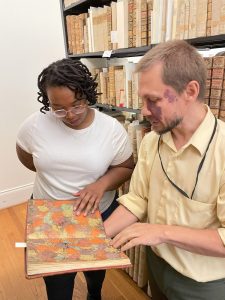
It was very interesting to see work from previous years, because I got to see how the department was run and what employees were doing to take care of the books and to expand the collection. Seeing the old course syllabi was also interesting, as I will be taking the Rare Books course in the upcoming fall semester, and I’ve heard great things about the course from my classmates in my Special Collections course, so I’m excited to experience it firsthand.
A mini project that I also worked on during my time in the department was with basic processing of new materials into the collection. The Catholic University of America’s Rare Books department received several boxes of pamphlets and books from other libraries that no longer wished to keep those items in their own collections. The pamphlets and books given to the university were focused entirely on some aspect of religion and religion-based groups and events. To organize them, I sorted the books in alphabetical order by publisher. The topics of the books ranged from everything, such as marriage expectations for men and women, conference overviews, prayers and songs, eugenics, the KKK, children’s expected behavior, etc. There was a wide range of publishers in the boxes, but several were very popular, such as: The Queen’s Work, The Paulist Papers, The Catholic Truth Society (with branches in New York, London, Ireland, Chicago, and San Francisco), Ave Maria Press, and Our Sunday Visitor. This was the last mini project that I worked on.
* * *
My favorite part of the internship were the times I was able to actively handle materials. Something Alex mentioned when I started is that a lot of people have this misconception of the rare books department and believe that rare book and special collections librarians are always rushing around acquiring new materials and touching the books and doing this or that, but the reality is very different. Usually, the average day for a person working in a library involves sitting at a desk answering phone calls, sending and responding to emails, and conducting research. With the Clementine Library, the only time I physically touched the books were when Alex and I had to go find several books on the shelf to figure out why seven books had the same call number.
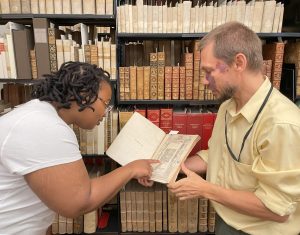
Aside from handling the books, I did really enjoy learning new things almost every day. The handwritten catalog information about the Clementine Library were all in Latin, as the books were mostly written in Latin, with some books being in other languages (German, Hebrew, French, etc.). Although I can’t quite read Latin, I have found myself being able to catch a few words here and there. A lot of the words are either very similar to the English language or closely resemble another language, such as the words libri in Latin and libro in Spanish, or the words theologica in Latin and theology in English.
Something that people may think about the Clementine Library is that it’s a collection that focuses solely on religion, but that is far from the truth. The books were about many different things, such as poetry, medicine, history, languages, etc. I really enjoyed seeing what the Albani family enjoyed reading many years ago.
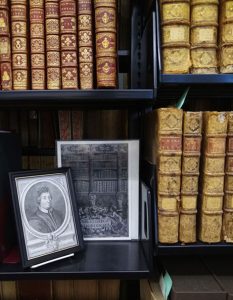
This practicum emphasized the importance of paying attention to details. As I mentioned above, there were instances where the same call number was assigned to multiple books. What this means is that multiple books had the exact same identification tag on them that identified where they were on the shelves. This was something that had to be fixed immediately, as it could cause issues for future researchers; they would search for one specific book using the call number and get seven completely unrelated books in their results. As I was inputting information, I noticed that I had typed the same call number several times and went back to review the documents. Bringing it to Alex’s attention, we had to go to the basement storage facility to track down every single book that had the same call number to identify what the problem was. The books in question were a set of pamphlets that were grouped together on the shelves and given the exact same identification number. To fix a problem like that, Alex and I had to open the books and identify the date of publication. That publication date would go at the end of the call number to make a clear, separate difference between the other books in the set.
The only thing about the internship that I struggled with was the chill in the room. The room is kept at a certain temperature and humidity to ensure the books remain in the best condition possible, so it is cold all the time. This is not something that anyone can change, but it does take some getting used to. If I had to give advice to incoming rare books workers, my first warning would be for them to bring a sweater.
* * *
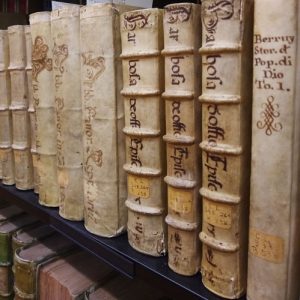
The first competency that really stuck out to me during my internship was the importance of negotiation and teamwork, and ethical management. Alex explained to me how items are acquired in the department and the necessary steps needed to verify everything the department received before it officially accepted it into its collection. Every item must have a clear chain of ownership. The details of ownership cannot be vague; heavy detail is preferred. The acquisition team is going to want to know where the book came from, the name of every person/institution that it belonged to, how much was paid for it, was the book altered in any way, is there a missing stamp of ownership from the previous institution that the item belonged to, is the title page inconsistent with other known copies of the book, etc. These questions must be answered because the university wants to avoid accepting an item that was obtained illegally, and they want to avoid paying a lot of money for a fraudulent book. There have been instances where an individual will steal an item from another library/institution and attempt to sell the book to make a profit. People have tried to alter books to make them resemble other editions so that the book would be worth more. Libraries work closely with verified rare book dealers and vendors to decrease the amount of fraud in the field. Each branch asks these questions to cover all their bases and to maintain credibility as trustworthy, reliable rare books specialists, even if that means spending weeks making phone calls and emails to track down every bit of information about a book.
Another objective that I developed an understanding of was the history and importance of the profession to the world. Libraries and information institutions share a common responsibility: capturing the diverse human experience and making that knowledge accessible. This is a very delicate line to walk because the diverse human experience will have things that are uncomfortable. There are items in the library that focus on heavy topics, such as racism. However, that’s not the overall message that the library is presenting to patrons. The purpose of the collection is to show all of history, the good and the bad, every perspective. This does not mean that the library or the university supports harmful statements and beliefs, just that they’re doing their duty of having the human experience documented. The Rare Books department at Catholic University does its best to capture the diverse human experience. In the Clementine Library, for example, a large amount of the books focus about Bibles and their contents. However, that is not the entire collection. The Clementine Library is a library that encompasses the books that the Albani family have owned and enjoyed since the 14th century. They weren’t just people who read Bibles and did absolutely nothing else. They read about poetry, romance, history, science, languages, politics, and other literature.
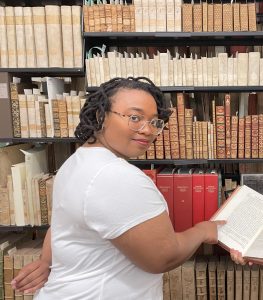
The contents of the books are not the only thing that can be educational. Even just looking at how a book was made in the 14th century as opposed to the late 18th century can tell someone a lot. With the department creating and maintaining that kind of environment, patrons can see what kind of topics and genres were popular a few centuries ago, which animals/materials were commonly used for book creation and binding, and see how those things changed over time.
Overall, I enjoyed my internship in the Rare Books department. I am very grateful for the opportunity that was given to me, and I enjoyed working with Alex, who is very knowledgeable and passionate about what he does in the department. This internship was a good introduction to the inner workings of a library for beginners, and I think it helped me gain a better understanding of what I can expect to see and experience as a library employee and what I want to do in the future.
* * *
University Libraries Special Collections are happy to provide practicum opportunities to CatholicU students interested in obtaining hands-on experience at our Archives and Rare Books. Contact us at lib-archives@cua.edu for more details.
